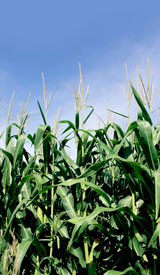

Grass-Based Agriculture
Projects
Grass as a Biofuel
J.H. Cherney, Dept. of Crop & Soil Sciences, Cornell University
It takes 70 days to grow a crop of grass for pellets.
It takes 70 million years to make the fossilized grass in fossil fuels.
The world-wide energy crunch is not going to disappear, as we are reminded with the weekly increases in heating oil prices. Sooner or later we will be forced to invest significantly in alternative fuel supplies. Progress towards self sufficiency is progress towards energy security. An ideal energy source should have the following traits:
- Cost-effective renewable energy supply
- An efficient conversion process
- High rural economic development potential
- High grower acceptance
- Environmentally friendly
- A positive impact on greenhouse gas production
Perennial grass has the potential to meet all of the above criteria. Any mixture or grasses can be cut in mid to late summer, left in the field to leach out minerals, then baled and pelleted. Drying of the hay is not required, making the cost of processing less than with wood pelleting.
New York State has a considerable acreage of unused or underutilized agricultural land. Much of this land is reverting back to woody growth. Some of it is in the conservation reserve program. Most of this land is not suited to growing row crops, but can and is currently growing grass crops. All of this land could grow grass crops for bioenergy, regardless of how marginal the soils are for agricultural production.
Cost Effective. Grass pellet energy is a promising alternative for rural communities. Perennial grass production is an efficient use of low-cost marginal farmland. Pelletized grass biofuel has the potential to become a major affordable, unsubsidized fuel source capable of meeting home and small business heating requirements at less cost than all available alternatives. Canadian economic studies have shown pelleted grass to be competitive with any of the conventional energy sources, and also competitive with wood pellets and short rotation willow biomass.
Efficient Energy Conversion. Pelleted grass has the same energy content as pelleted wood, with essentially the same BTUs per pound. Perennial grass can be pelleted and used successfully as a heating source, if the ash content is relatively low. Older style wood pellet stoves will not effectively burn high ash fuels. New appliances are being designed specifically to burn materials with relatively high ash content, and are EPA-certified to have very low particulate emissions. Fossil fuel inputs for field production, biomass processing and energy conversion are minimal. The ratio of total energy output:energy input for the pelleted grass system is estimated to be as high as 15:1. Newly designed pellet stoves have fuel conversion efficiencies around 85%, in the same range as modern oil furnaces.
We have burned grass pellets as high as 5% ash in pellet stoves at the Cornell Mt. Pleasant research farm. Small scale pellet boilers providing central hot water heating are currently being developed in Europe to burn reed canarygrass pellets. A small scale gasifier for generating electricity and heat operated by Community Power Corporation of Pennsylvania was successfully tested using grass pellets from Cornell. Washington State Dept. of Water and Energy has funded a producer proposal for a downdraft gasifier to convert bluegrass straw/stubble to electricity.
Rural Economic Development Potential. A low-technology, small-scale alternative energy system means local production, local processing, and local consumption. Grass energy farming will result in economic diversification and absorb excess production capacity on farms. Small scale and local production results in rural jobs. Additionally, the use of inexpensive grass pellet fuels will allow rural residents to redirect funds they usually spend on conventional energy, and this means more money in the local economy. The pellet processing can occur in conventional pelleting facilities, or mobile pelleting facilities are now an option. We successfully pelleted a variety of grass species this fall using a mobile pelleting unit stationed in Quebec, Canada.
Grower Acceptance. In the near term, biomass systems must be able to effectively integrate with existing farming systems to achieve widespread adoption. Grower acceptance should be very high. Grass management is relatively simple and has maximum compatibility with existing farm operations-- most farmers already grow grass. Grass crops have dual use potential as an energy crop and as livestock forage. All equipment needed for grass management is currently available on farms. In many cases there is no need to plant a crop if a grass stand already exists. Any agricultural land resource can be used for this purpose. Harvest occurs in mid to late summer and is flexible to avoid other farm tasks.
Environmental Benefits. New York State generates approximately 1% of the world�s greenhouse gasses, more gas production than several European countries generate. Grass biofuel pellets emit up to 90% less greenhouse gasses than conventional energy sources such as oil, coal and natural gas. If approximately 5.5% of all residential buildings in New York State were heated with pelleted grass or wood, this would offset 100% of all green house gas emissions caused by agriculture in New York State. Grass biofuel also can make a positive contribution to sustainable agriculture through increasing farm diversification and increasing the land base under perennial cover. Perennial grass is ideal for animal manure nutrient management, soil conservation, maintaining open spaces, and compatible with wildlife nesting opportunities. A simple one cut per season perennial grass biomass program has maximum sustainability for an agricultural cropping system.
Cornell University is working together with Midwestern Universities and USDA researchers to start to address and resolve the outstanding issues facing this biomass production system. Grass pellet biofuel is a very promising sustainable, economically-viable, and environmentally-friendly alternative energy source. It has great potential for near-term implementation and positive impact on rural New York communities. Unfortunately grass has no political lobby, which makes the start up of any new industry problematic.
For more information, visit http://www.GrassBioenergy.org
